Kunafa is an incredibly DELICIOUS Middle Eastern dessert made with a creamy milk pudding between two layers of crispy shredded dough and drizzled with sugar syrup. I also like to top it with pistachio. It is super delicious hot or cold.
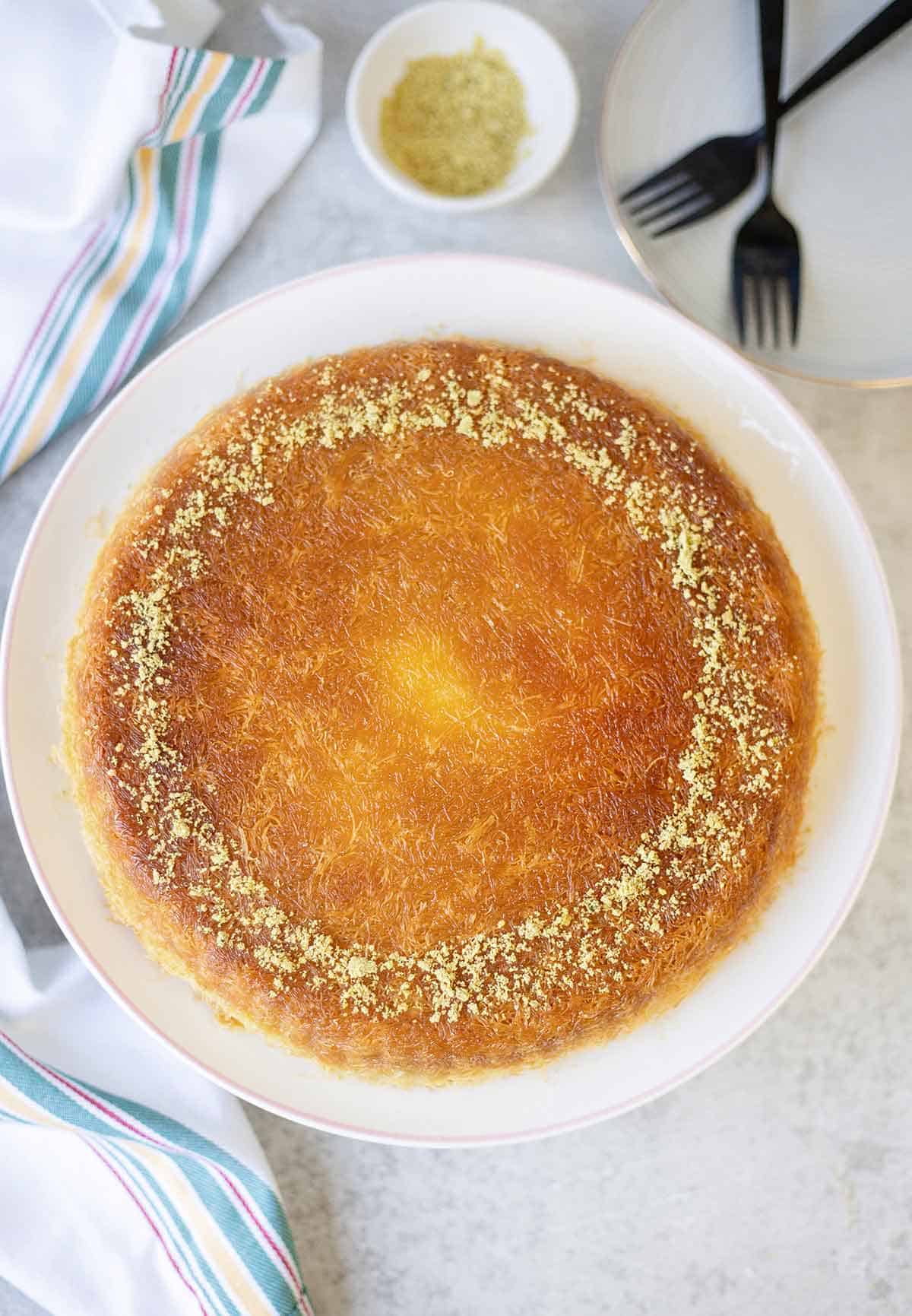
Kunafa
Kunafa (sometimes called Knafeh) is a traditional and popular Ramadan dessert in all Middle Eastern countries, especially Egypt.
There are many different styles of Kunafa in the Middle East; there is Kunafa with nuts, cream, chocolate pudding, Nutella or cheese (usually Akkawi or Mozzarella). It can also be fried or baked.
My favourite is Kunafa with cream, the one we will be making today; all my family love it!
It has a creamy gooey from the inside and crunchy from the outside. It is soaked in sugar syrup, so it is sweet and delicious.
Outside the Middle East, you can find the frozen Kunafa dough in Turkish or Greek food stores. They are usually labelled as Kataifi, and in Arabic labelled 'كنافة '.
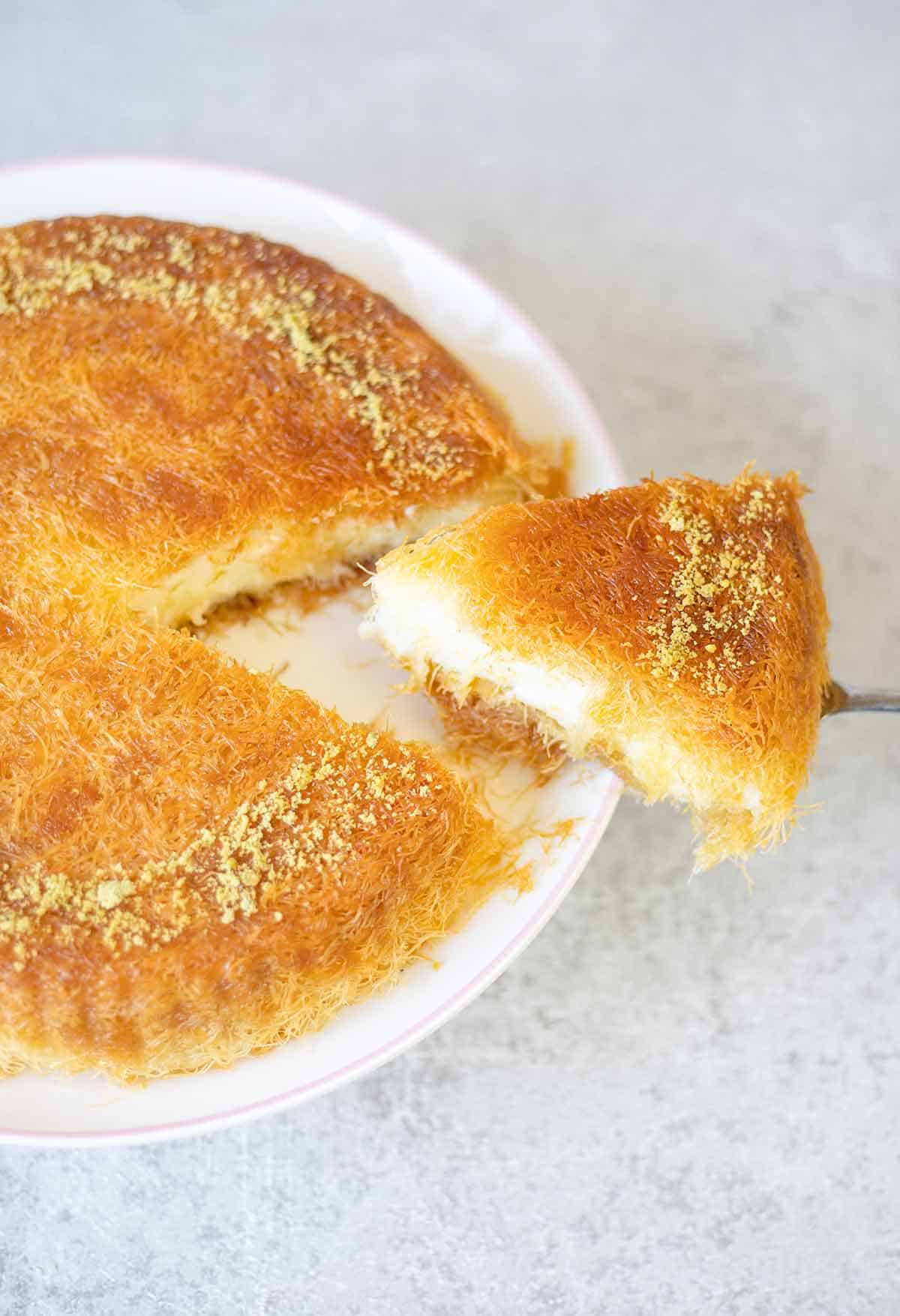
Kunafa Ingredients
“See the recipe card for full information on ingredients and quantities.”
Kunafa dough: It is thin shredded filo dough; you can't just shred a filo dough sheet to have Kunafa. It is made with totally different ingredients. I bought it from a Middle Eastern grocery store.
Ghee: Gives better results than butter. I highly recommend using good quality ghee! If you only have butter, you can clarify it first before using.
To make the syrup: I used white sugar, vanilla extract, lemon juice, water and glucose liquid (helps in thickening the syrup).
To make the cream: I used heavy cream, cornflour, vanilla extract, and a small amount of sugar because we will add syrup, and we don't want it to be too sweet.
Topping: I use pistachio; however, you can use any variety of nuts you like.
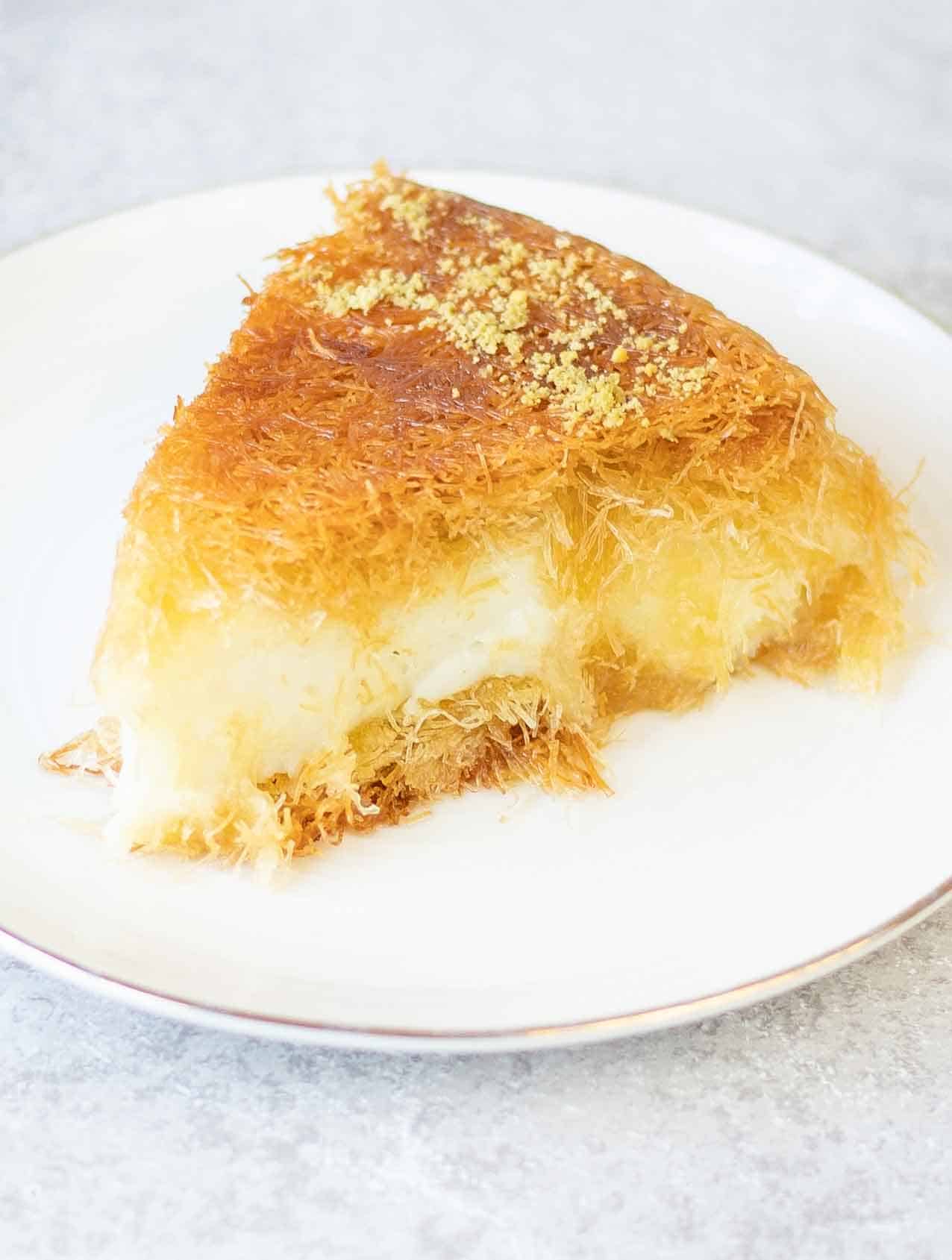
How To Make Kunafa?
Make The Syrup
One: In a small saucepan, add sugar and water over high heat and bring to a boil (don't stir it, that will cause crystals to form in the syrup). Once it is boiling, turn the heat down, add the glucose liquid and let it simmer for 5-6 minutes.
Two: Next, add vanilla extract and lemon juice, stir, then turn off the heat.
Three: Put the syrup in a cool place and let it cool down completely.
Prepare The Cream (Ashta)
One: In a small saucepan, add sugar, cornflour and milk, stir well to combine (use a whisk). Keep mixing until there are no lumps at all.
Two: Put the saucepan over medium heat and constantly stir for 2-3 minutes until it comes to a boil. Keep whisking until the mixture thickens then, add vanilla extract, stir and turn off the heat.
Three: Pour the cream into a bowl, then cover the top with plastic wrap to prevent a skin from forming, leave it to cool down completely.
Prepare The Kunafa
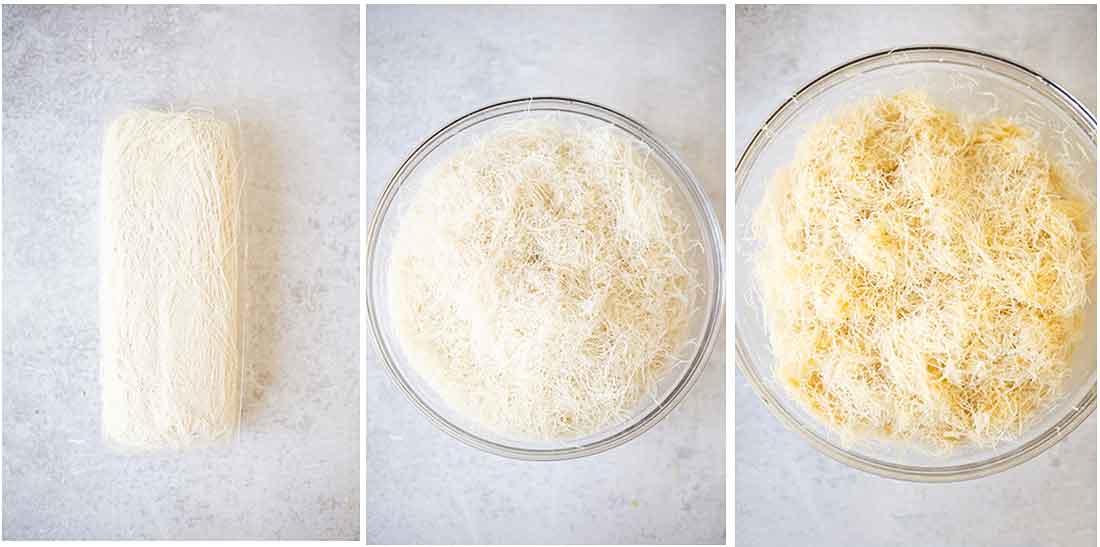
Before starting, preheat the oven to 190C / 380F and grease a 10-inch baking pan with ghee. spread the ghee well in the bottom and the sides of the pan.
One: Put the Kunafa dough in a large bowl, then use your hands to tear it or use kitchen scissors to cut it into 2-3 cm strips. Try to separate the individual strands from each other,
Tip: My mother usually cut the dough in the food processor; however, I found this way a little messy.
Two: When you have a pile of fine strips of Kunafa, pour the melted ghee on top of it, and mix it thoroughly (rub the dough with ghee using your hands).
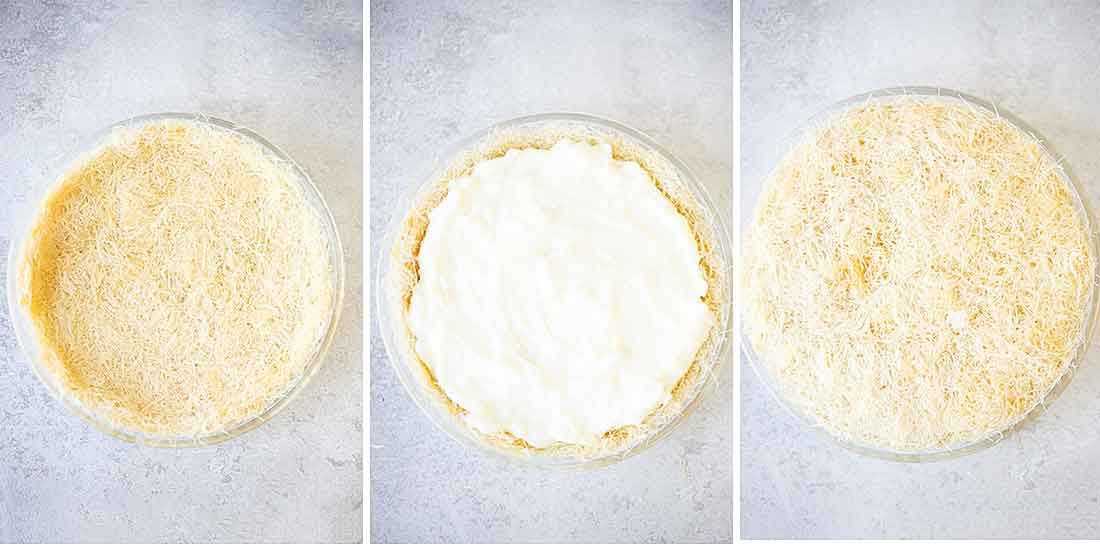
Three: Grab a handful of Kunafa dough and add it to the pan, fluff it up while adding it, so you don't get any clumps. Keep adding it until you cover the pan bottom with the dough.
Four: After that, use any heavy object such as a measuring cup to press on it until you get a flat layer.
Five: Now add more dough around the edges of the tray and press on them as well.
Six: Pour the cream filling in the centre of the pan and spread it out over the first layer. Once the cream is spread, fold in any excess dough walls down over the layer.
Seven: Start gently covering the cream layer with the rest of Knafeh. Once you have created a thin layer on the top, press it down gently using both your hands (don't press on it so hard that the cream comes out). Sprinkle some melted ghee on the top (optional).
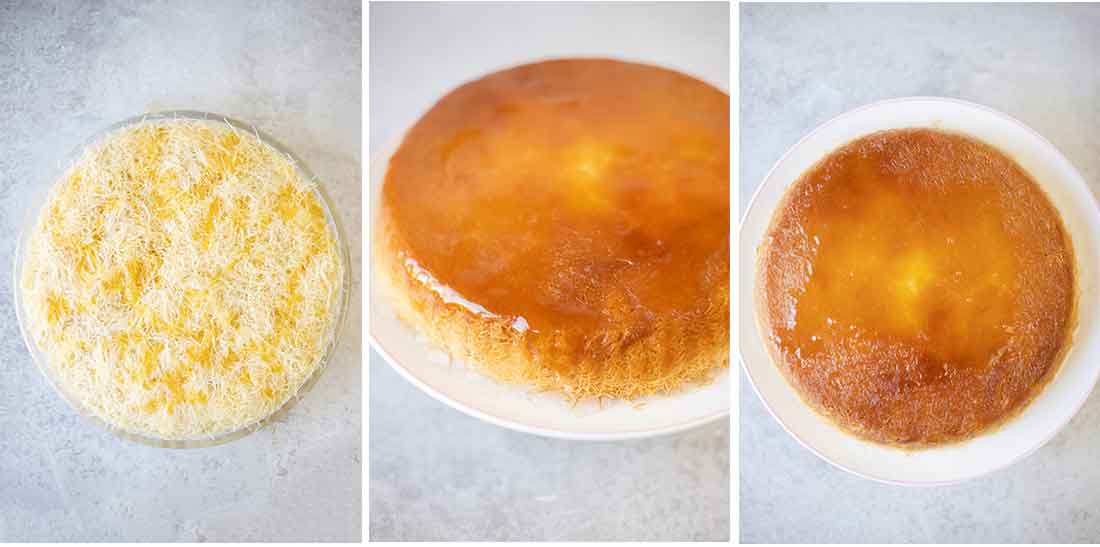
Eight (Baking the Kunafa): Put the pan in the middle of the oven and bake for 40-45 minutes or until the top becomes golden brown. Take it out of the oven.
Nine (Applying The Syrup): As soon as you remove the it from the oven, pour the syrup evenly over the top. You will hear a sizzle as you pour the syrup into the Kunafa. Let it sit for 10 minutes so all the syrup is absorbed.
Ten: Place a serving plate over the baking pan, and flip it onto the plate. Decorate it with the chopped pistachio, then cut it and serve.
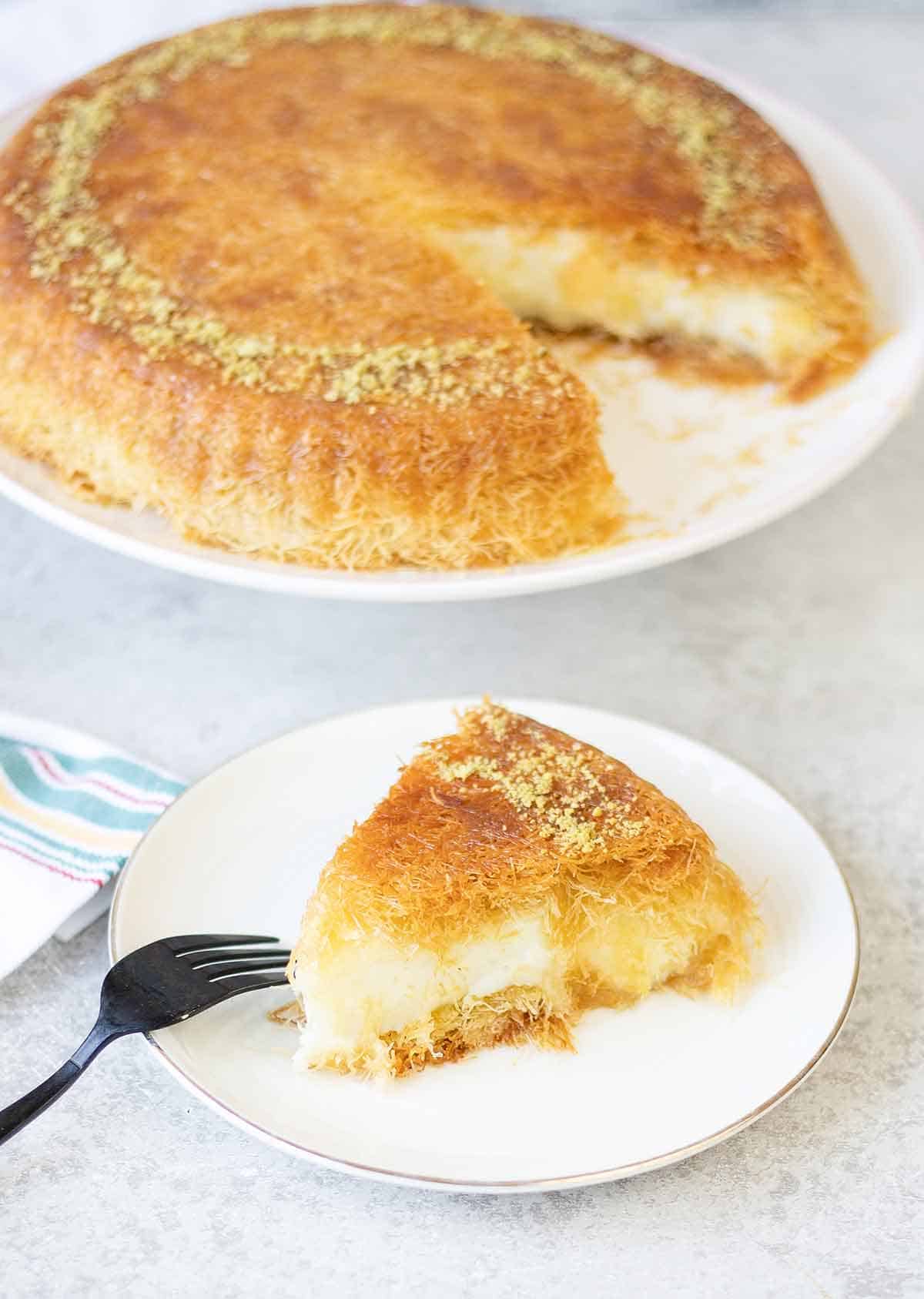
Expert Tips!
- Use your hands (don't use a spoon or spatula) to rub the dough with the ghee until all the ghee is absorbed.
- Drizzle the Kunafa with the syrup as soon as you take it out of the oven (hot); the syrup should be cold.
- I keep my uncooked dough in the freezer for up to 3 months.
Variations & Substitutions
- Add orange blossom to the syrup for a more robust flavour.
- Swap pistachio for hazelnut.
- Make this recipe with different fillings such as chocolate pudding or Nutella.
- Add a few drops of rose water to the syrup if you like.
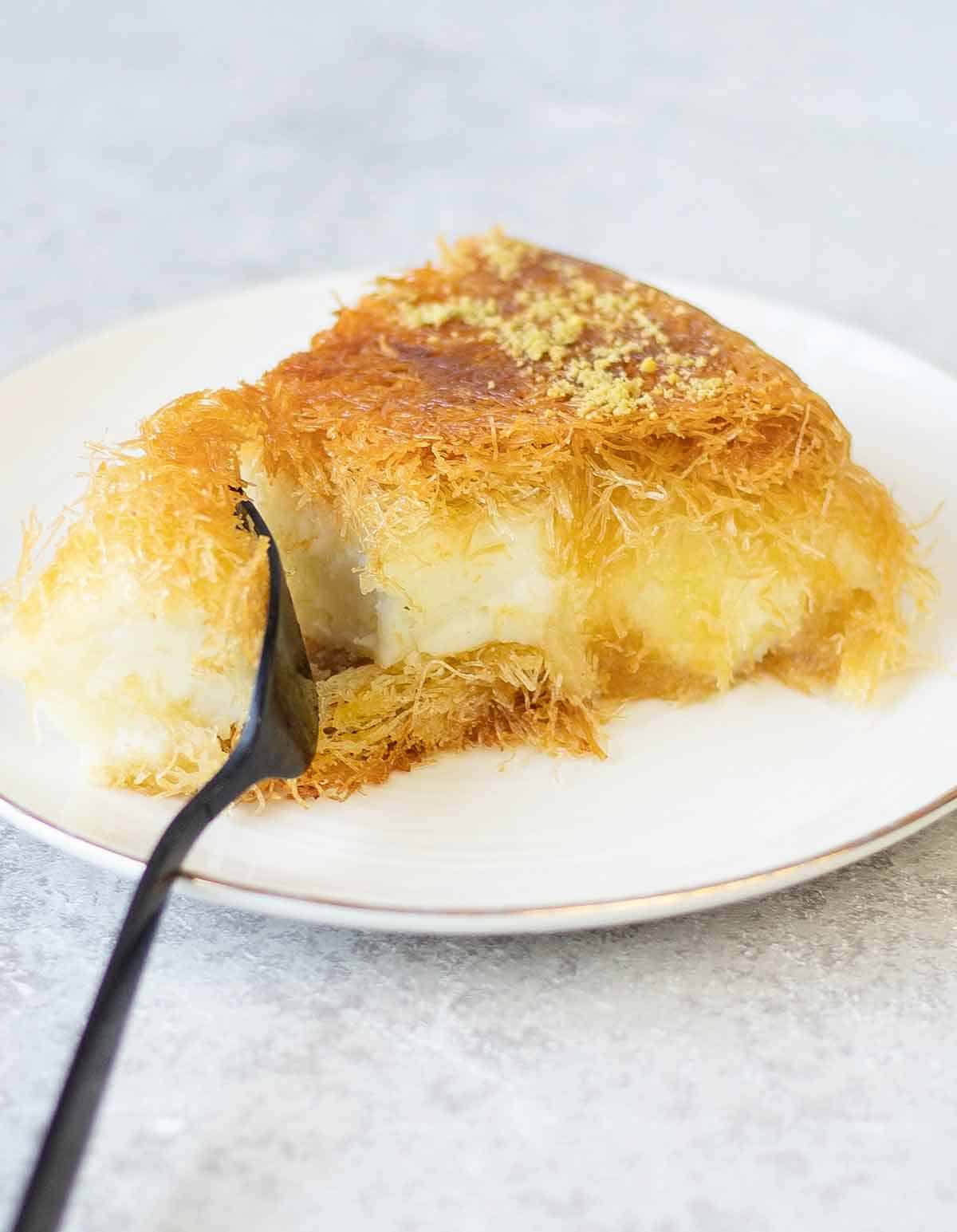
Storing, freezing and reheating
To Store: I keep it well covered in the fridge for 3-4 days, no problem.
Freezing: Kunafa freezes beautifully. Just put it in a well-sealed container in the freezer for 2-3 months.
Reheat: Defrost at room temperate overnight, then microwave for 40 seconds; it needs it to be warm, not hot. Also, I like to drizzle it with some syrup!
To Make It Ahead Of Time: Make this dessert, add the syrup and then put it in the fridge for 2-3 days. Before serving, you can microwave for 1 minute or so if you like it warm.
Another method: Prepare the syrup, let it cool completely, then put it in a well-sealed jar in the fridge.
Prepare the cream filling, let it cool down, then cover well and put in the fridge. Rub the dough with ghee. Assemble everything before serving (My favorite method).
Serving suggestions
Drizzle it with extra syrup and sprinkle some finely chopped nuts on top. Cut it and serve with hot drinks such as green or red tea.
Personally, I love to serve it with a cup of Oat Milk Hot Chocolate or White Chocolate Latte.
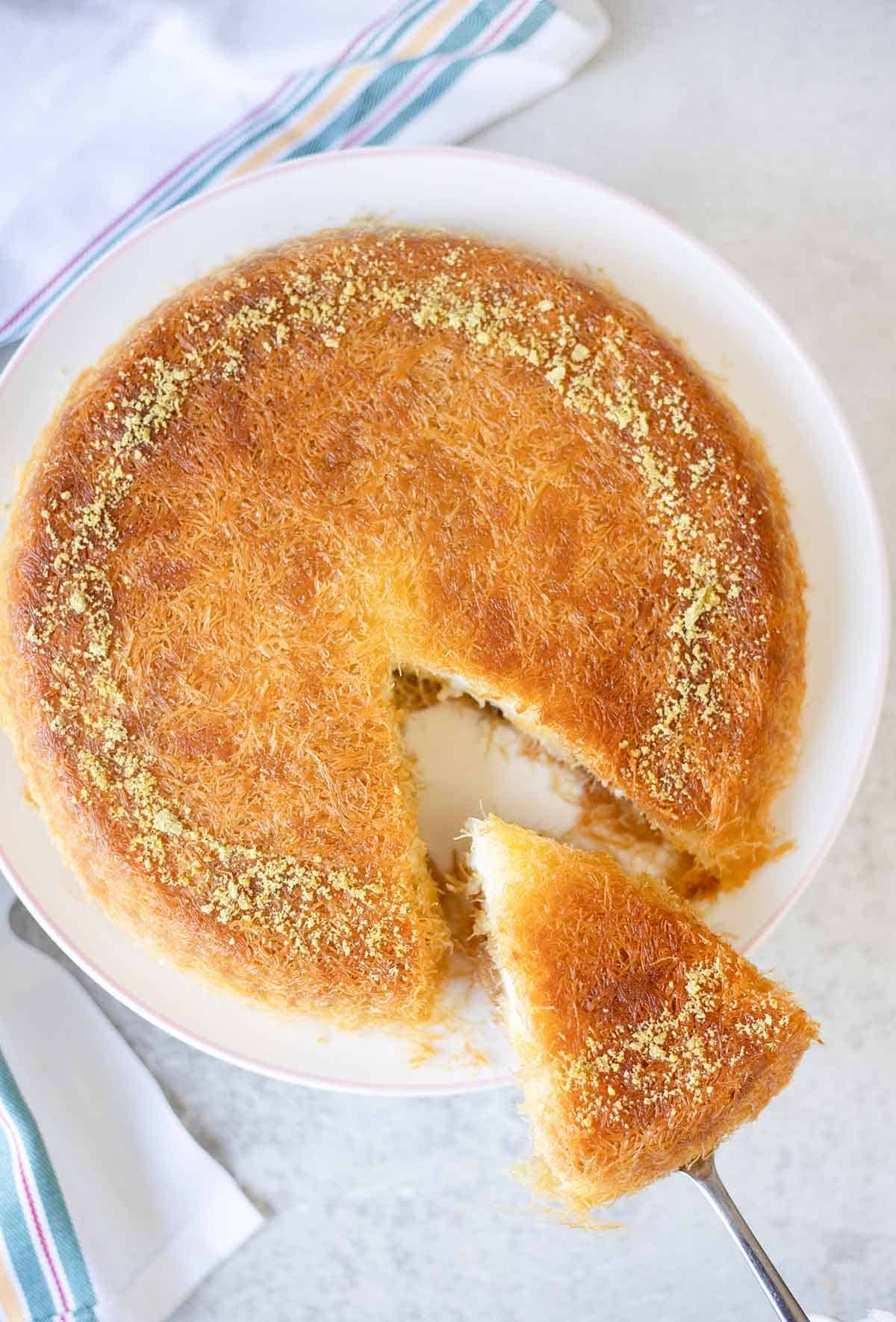
More Kunafa Recipes
Easy Middle Eastern Dessert Recipes
Thank you for checking out my recipe! Follow me on Facebook and Pinterest to keep up-to-date with all new recipes. Also, you can subscribe to my Newsletter to recipe all the new recipes once published.
Recipe Card
Kunafa Recipe
Ingredients
- 400 g Kunafa
- 250 g ghee
For the Syrup
- 2 cups sugar
- 1 teaspoon vanilla extract
- ½ teaspoon lemon juice
- 1 cup water
- 2 tablespoon glucose liquid
For the cream
- 3 cups milk
- 6 tablespoon cornflour
- 4 tablespoon sugar
- 1 teaspoon vanilla extract
Topping
- 2 tablespoon pistachio , finely minced
Instructions
Make the syrup
- In a small saucepan, add sugar and water over high heat and bring to a boil (don't stir it, that will cause crystals to form in the syrup). Once it is boiling, turn the heat down, add the glucose liquid and let it simmer for 5-6 minutes.2 cups sugar, 1 cup water, 2 tablespoon glucose liquid
- Next, add vanilla extract and lemon juice, stir, then turn off the heat. Put the syrup in a cool place and let it cool down completely.1 teaspoon vanilla extract, ½ teaspoon lemon juice
Prepare the filling
- In a small saucepan, add sugar, cornflour and milk, stir well to combine (use a whisk). Keep mixing until there are no lumps at all.6 tablespoon cornflour, 4 tablespoon sugar, 3 cups milk
- Put the saucepan over medium heat and constantly stir for 2-3 minutes until it comes to a boil. Keep whisking until the mixture thickens. Once it has reached the consistency of the cream , add vanilla extract, stir and turn off the heat.1 teaspoon vanilla extract
- Pour the cream into a bowl, then cover the top with plastic wrap to prevent a skin from forming, leave it to cool down completely.
Prepare the Kunafa
- Preheat the oven to 190C / 380F.
- Put the Kunafa in a large bowl, then use your hands to tear it or use kitchen scissors to cut it into 2-3 cm strips. Try to separate the individual strands from each other. When you have a pile of fine strips of dough, pour the melted ghee into the dough and mix it thoroughly (rub the Kunafa with ghee using your hands).400 g Kunafa, 250 g ghee
- Grease a 10-inch baking pan with ghee. Spread the ghee well in the bottom and the sides of the pan.
- Grab a handful of the dough and add it to the pan, fluff it up while adding it, so you don't get any clumps. Keep adding it until you cover the pan bottom with dough. After that, use any heavy object such as a measuring cup to press on the Kunafa until you get a flat layer.
- Now add more dough around the edges of the tray and press on them as well.
- Pour the cream filling in the centre of the pan and spread it out over the first Kunafa layer. Once the cream is spread, fold in any excess Kunaff walls down over the layer.
- Start gently covering the cream layer with the rest of Kunafa. Once you have created a thin layer of the Kunafa on the top, press it down gently using both your hands (don't press on it so hard that the cream comes out of the Kunafa).
- Put the pan in the middle of the oven and bake for 40-45 minutes or until the top becomes golden brown. Take it out of the oven.
- As soon as you remove the Kunafa from the oven, pour the syrup evenly over the top. You will hear a sizzle as you pour the syrup into the Kunafa. Let it sit for 10 minutes so all the syrup is absorbed.
- Place a serving plate over the baking pan, and flip the Kunafa onto the plate. Decorate it with the chopped pistachio, then cut it and serve.2 tablespoon pistachio
Notes
- Use your hands (don't use a spoon or spatula) to rub the dough with the ghee until all the ghee is absorbed.
- Drizzle the Kunafa with the syrup as soon as you take it out of the oven (hot); the syrup should be cold.
- I keep my uncooked Kunafa dough in the freezer for up to 3 months.


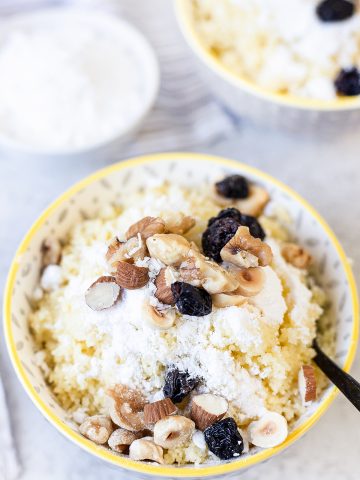
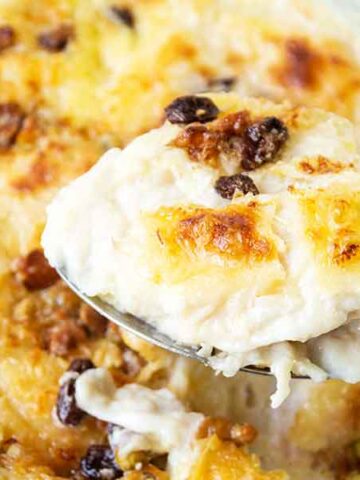
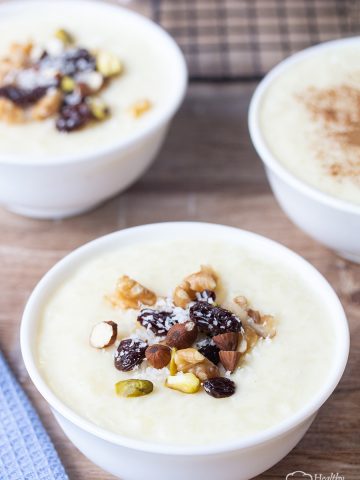
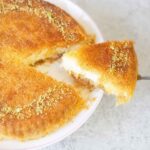
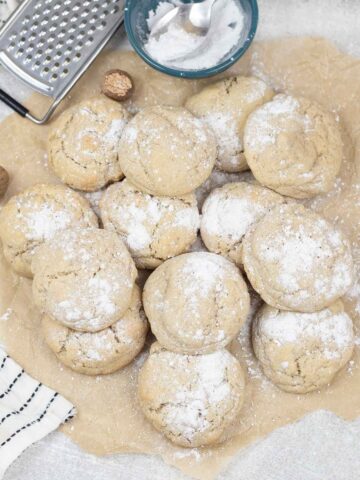
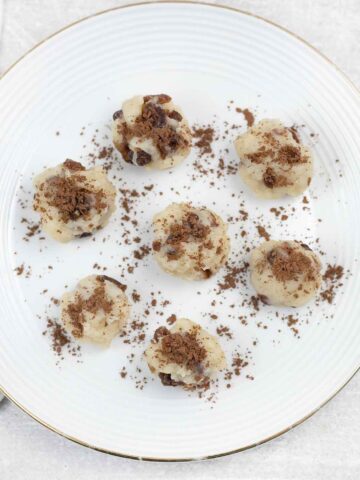
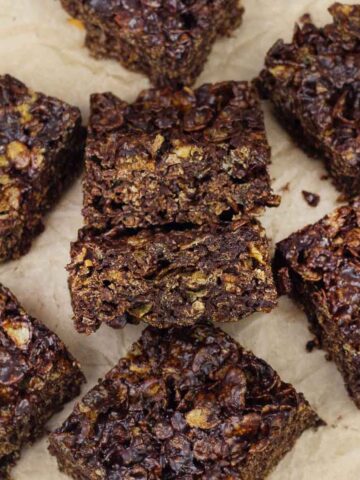
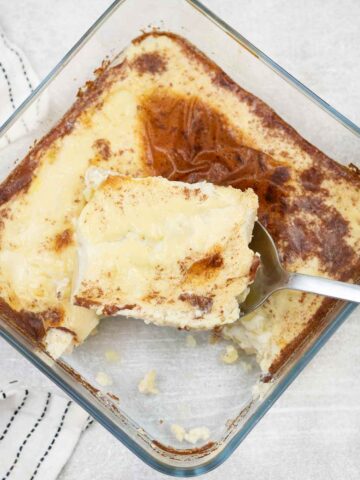
Marwa
Delicious! I added nuts to the cream.
Caroline
What a lovely dessert; the cream filling was amazing too.
Aurora
I made this Kunafa recipe, but I replaced the creamy filling with Nutella, and it turned out so delicious.
Charlotte
Wow! I adore Kunafa; actually, I love all the Mediterranean desserts. I made this recipe today, and it was more than beautiful.
Nura
Did you use cornflour or cornstarch?
Radwa
Both are the same thing.